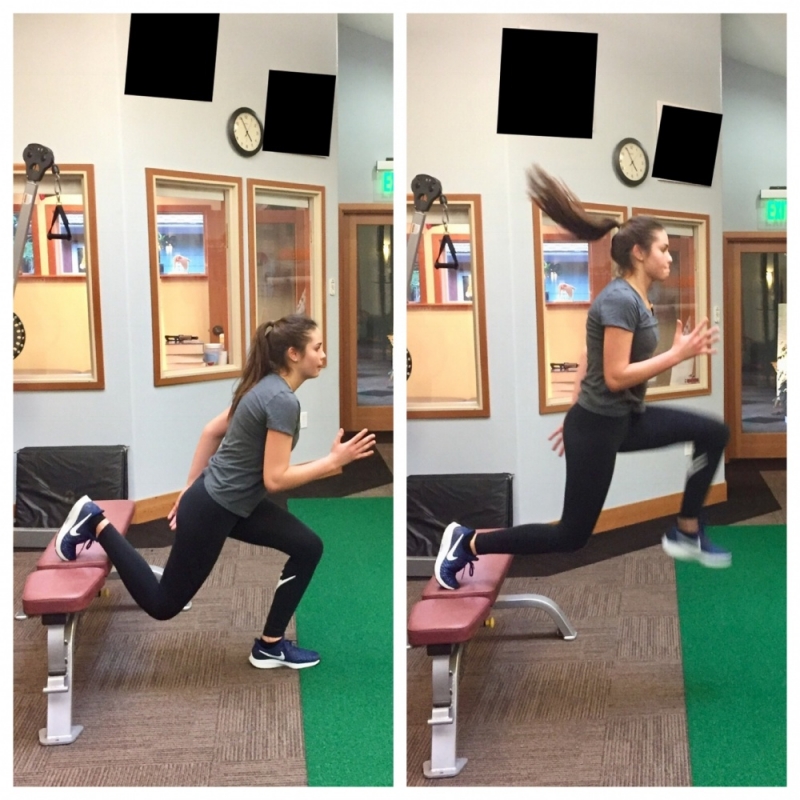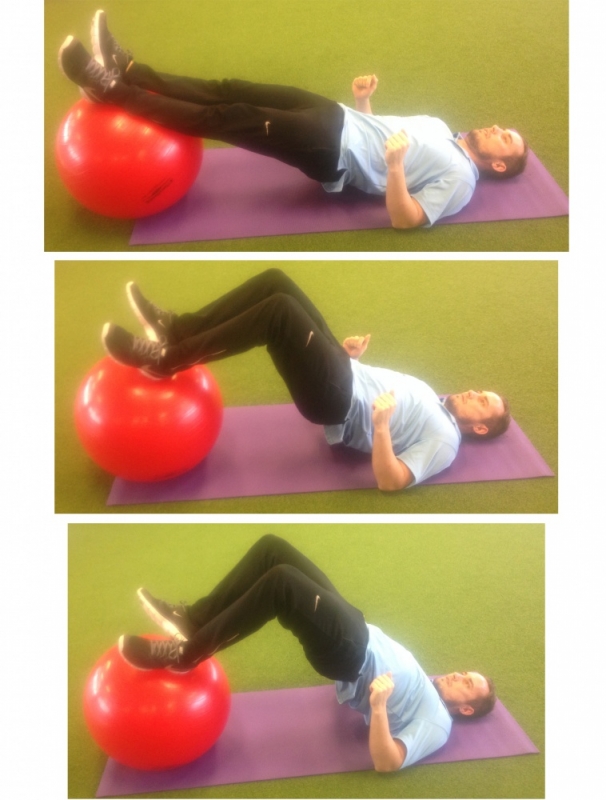RUNNING IMPAIRMENT
Overstriding is defined as an excessive distance between where the foot lands at initial contact in comparison to the center of mass (Miller, 2002). This can observed during the terminal swing phase of gait into the initial contact phase (foot hits the ground). Often excessive knee extension will be observed, lack of adequate hip flexion and sometimes a heavily dorsiflexed ankle. It should be noted it is not uncommon to see forefoot strikers utilize this movement pattern as well and land with a straight knee extended in front of them (commonly seen via elite runner Kenenisa Bekele in the past, although not currently it seems after beginning marathon training/racing).
Image via Andrew Redington
This can occur for a multitude of reasons. Hamstring eccentric strength is definitely worth considering, as the hamstrings work very hard toward the end of the swing phase of gait to control the forward swing of the tibia and femur at the knee and hip. An excessively straight knee at this phase may suggest the hamstrings may not have enough strength to control that forward swing.
Glute max and quadriceps strength are two other major areas worth investigating with this movement impairment. During the terminal swing phase of gait, the quadriceps and glute max begin to activate in preparation for absorbing impact during the loading response or landing phase of gait (Perry, 2002). These are the primary shock absorbing muscles during this phase (Hamner, Seth, Delp, 2010). Lack of hip flexion and an straight knee are strategies some individuals may use to attempt to decrease load on these muscles. Unfortunately, this may place greater load through the knee joint. As I discussed in a post regarding excessive knee flexion (Knee Forward to Toes Movement Impairment), excessive knee flexion can be problematic. A lack of knee flexion can ALSO be problematic as it suggests the individual is trying to avoid using the muscle. The stronger a muscle is, the more joint motion you will see (Stearns, Keim, Powers, 2013). Lack of adequate knee flexion (optimally ~30-40 degrees during initial contact) and hip flexion (optimally 20-30 degrees during initial contact) may suggest that individual is trying to avoid active shock absorption of the knee and hip (Powers, 2018). Passive shock absorption is not optimal as this occurs in your joints, ligaments, etc. Reasons for avoiding active shock absorption usually revolve around weakness and the body attempting to protect the muscle from being overused or damaged. So the strength of these muscles is critical for normal landing mechanics.
Finally, flexibility or coordination deficits may also contribute to this type of form. Stiff calves may lead some individuals to land forward of themselves in a plantarflexed position. Lack of adequate hamstring flexibility may also limit hip flexion as this group is a hip extensor. This could also be a movement pattern that the individual picked up for whatever reason.
Image via flickr (boma.dfoto)
ASSOCIATED INJURIES
Landing farther forward with a straight knee usually means larger magnitudes of breaking forces (Lieberman et al., 2015). The larger the braking forces, the larger the forces associated with impact. This may potentially put athletes at risk for stress related injuries like compartment syndrome or joint related issues. There is some evidence for overstriding and compartment syndrome in the lower legs. Sugimoto et al. (2018) recently performed a study that suggested a link with an overstride gait characteristic, along with excessive dorsiflexion, to female runners with compartment syndrome in the lower extremity. So for those at risk for impact related injuries (stress fractures, compartment, syndrome), this kind of movement impairment may need to be addressed (along with training modifications).
The hamstrings are a commonly injured muscle group, particularly with higher speed running and sprinting. The hamstrings are particularly vulnerable during the late phases of swing (ie terminal swing) due to the high eccentric load placed upon them to control the lower extremity (Chumanov, Beiderscheit, Thelen, 2011). Poor eccentric strength to control that motion or the movement coordination deficit causing repeated over-lengthening of the hamstrings may put this muscle group at risk (Chumanov, Schache, Beiderscheit, Thelen, 2012)
Image via www.zehabesha.com
Landing with a straight knee means less muscular shock absorption and more joint related shock absorption. Thus overstriding mechanics may place individuals for increased load at the tibiofemoral (knee) joint and may be a source of symptoms with knee pain (Powers, 2018). Appropriate knee flexion is important for adequately loading the quadriceps muscle and without it there may be increased joint stress (Stearns et al., 2013).
Although this seems a bit removed, low back pain may be an associated injury due to poor shock absorption at the lower extremity with this movement impairment. With poor shock absorption down below means increased spinal compression to attenuate shock up above (Powers, 2018). This is similar to landing on a stiff rod versus an absorptive spring. With the repetitive loads that come with running, this movement impairment may be a source of symptoms for low back pain associated with running.
That looks better.....
CORRECTIONS
Bulgarian Split Squat
Although the step up is an equally good exercise, the Bulgarian Split squat is a favorite of mine for appropriately loading the hip extensors (including the hamstring) while working on single leg stance mechanics in a similar motion to running into hip and knee flexion. To further advance this and add a high load, a hop can be introduced by pulling the heel of the stance foot up toward the buttock (this is highly advanced and not for those that are not conditioned. This variation is dangerous if you are not prepared).

An extremely advanced variation of the split squat is to turn it into a split squat jump. Further difficulty can be added by pulling your contact foot up toward your hip to further challenge the hamstrings. (Image from HEP2GO)
Triple Threat Hamstring Exercise
The Triple Threat Swiss Ball exercise is another great way to load and strength the hamstrings and hip extensors. The hamstrings are both knee flexors and hip extensors, so training both motions is important for strength and health of this muscle group. Focus should spent especially on slow controlled motion on the way back down to improve the eccentric load capabilities of the hamstrings and hip extensors.

(Image from HEP2GO)
High Knee Drills/Running in Place/Uphill Running
If coordination is an issue, there are a variety of ways to train this out. The high knee drill is a common way to train a high knee drive instead of reaching forward with the foot. Running in place is similar and works well because you cannot overstride when running in place. One of the most functional and best for performance improvement is uphill running. The movement pattern required for running requires a flexed knee and hip position and most people will naturally land closer to their center of mass and lean forward. These have to be practiced continuously as movement patterns take a long time to undo, recreate and maintain! This will take months to years to implement, so do not rush things. Don't create a new injury trying to fix something. The body needs time to adapt.
This is a common but fixable issue among the running population. If you have hamstring or impact related injuries, this is something you may want to investigate. The side effect of the decreased braking is that you may run a little more efficiently. Less braking forces means more forward momentum. More forward momentum means more efficiency and speed. So if you want either of those two things, you should work on this.
Thanks for reading!
Matthew Klein, PT DPT OCS FAAOMPT
Doctor of Physical Therapy
Board Certified Orthopedic Clinical Specialist
PhD Student APU: Rehabilitation and Movement Science
Fellow of the American Academy of Orthopedic Manual Physical Therapists
Doctor of Physical Therapy
Board Certified Orthopedic Clinical Specialist
PhD Student APU: Rehabilitation and Movement Science
Fellow of the American Academy of Orthopedic Manual Physical Therapists
***Disclaimer: As always, my views are my own. My website should not and does not serve as a replacement for seeking professional medical care. I have not evaluated you in person, am not aware of your injury history and personal biomechanics, thus am not responsible for any injury that you may incur from the performance of the above. I have not prescribed any of the above exercises to you and thus again am not responsible for any injury that may occur from the performance of the above. This website is meant for educational purposes only. If you are currently injured or concerned about an injury, please see your local physical therapist. However, if you are in the LA area, I am currently taking clients for running evaluations.
REFERENCES
1. Chumanov, E., Schache, A., Heiderscheit, B., Thelen, D. (2012). Hamstrings are most susceptible to injury during the late swing phase of sprinting. British Journal of Sports Medicine; 46: 90
2. Chumanov, E., Heiderscheit, B. & Thelen. (2011). Hamstring Musculotendon Dynamics during Stand and Swing Phases of High Speed Running. Medicine & Science in Sports & Exercise: 43(3): 525-532.
3. Hamner, S., Seth, A., Delp, S. (2010). Muscle contributions to propulsion and support during running. Journal of Biomechanics, 43(14): 2709-2716. doi: 10.1016/j.jbiomech.2010.06.025
4. Lieberman, D., Warrener, A., Wang, J., Castillo, E. (2015). Effects of stride frequency and foot position at landing on braking force, hip torque, impact peak force and the metabolic cost of running in humans. Journal of Experimental Biology; 215, 3406-34145. Miller, T. (2002). Programmed to Run, Champaign, IL: Human Kinetics
6. Perry, J. (1992). Gait Analysis: Normal and Pathological Function. Thorafare, NJ: SLACK Incorporated.
7. Powers, C. (2018). Evaluation and Treatment of the Injured Runner. (Lecture and Power Point). Los Angeles, CA.
8. Stearns, M., Keim, R., Powers, C. (2013). Influence of relative hip and knee extensor muscle strength on landing biomechanics. Medicine & Science in Sports & Exercise; 45(5): 935-941
9. Sugimoto, D., Brilliant, A., D/Hemecourt, D., D'Hemecourt, C., Morse, J., D'Hemecourt, P. (2018). Running mechanics of feamles with bilatreal compartment syndrome. The Journal of Physical Therapy Science, 30: 1056-1062
Like and Follow Doctors of Running
Facebook: Doctors of Running Twitter: @kleinruns
Instagram: @doctorsofrunning Direct Contact: doctorsofrunning@gmail.com
Please feel free to reach out, comment and ask questions!












